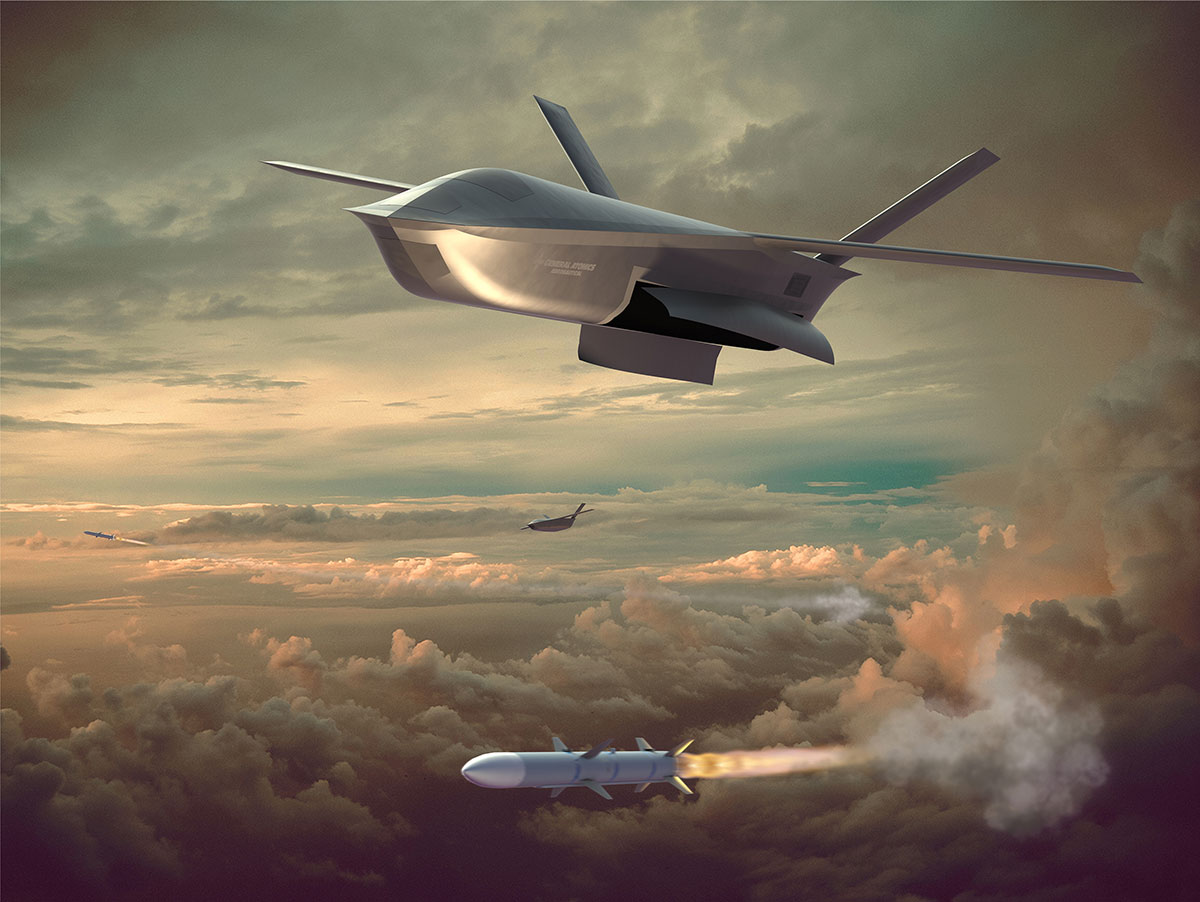US defense giant General Atomics recently released the first concept image of a missile-carrying air-to-air combat drone which the firm is developing as part of the DARPA’s LongShot program.
The development of the combat drone is part of the US government-run Defense Advanced Research Projects Agency’s (DARPA) LongShot program, which seeks to significantly increase the engagement range and effectiveness of air-to-air weapons.
In practice, the program aims to launch an unmanned drone carrying missiles close to the enemy territory from an aircraft or bomber.
This way, LongShot is envisioned to increase the survivability of manned platforms by allowing them to be at standoff ranges far away from enemy threats, while an air-launched LongShot UAV efficiently closes the gap to take more effective missile shots, DARPA’s statement noted.
The concept image released by General Atomics Aeronautical Systems (GA-ASI) becomes the third one after DARPA and Northrop Grumman, another leading defense manufacturer, had released their own versions in February this year.
The Concept Image
The California-based company released an article titled ‘GA-ASI: The Future of Small UAS’ highlighting the current projects the company is working on. Among other SUAVs like Sparrowhawk and MQ-1C Gray Eagle, there was an artist rendering of DARPA’s LongShot.
The article described the futuristic drone which can be “launched from larger UAS or human-crewed aircraft and charge into hostile airspace armed with its own air-to-air missiles, able to fire on enemy targets if it were so commanded”.
Talking about the versatility of the weapon, the article listed the ways in which LongShot can be deployed such as “initiating a fighter sweep ahead of a strike wave without putting a human crew in danger or joining an attack alongside the vanguard with human-crewed warplanes or could give legacy aircraft such as bombers a potent new anti-air capability”.
General Atomics’ version shows a cockpit that looks much like a B-52 stealth bomber but without the need for the cockpit windows. It seems that the drone needs a comparatively larger-looking fuselage to house the combat weapons it is designed to deliver.

Speculating on the size of the drone, The Drive reported that it seems big enough to host radar-guided air-to-air missiles, including AIM-120 Advanced Medium-Range Air-to-Air Missile, or AMRAAM.
Earlier DARPA released its own concept art of LongShot, showing a stealthy cruise missile-like vehicle, with pop-out fins and rear-mounted air-breathing engine while firing two smaller air-to-air missiles.
Similarly, two days after getting the contract, Northrop Grumman revealed its concept image of the advanced technology weapon. The image had an airplane-like platform and a more traditional wing and tail configuration.

The Drive noted that Northrop Grumman’s LongShot concept has stealthy features, including a chined fuselage, it is shown carrying a pair of missiles externally, which would increase its overall radar cross-section.
Video Of A Shiny, Shape-Shifting UFO Goes Viral, Sparks Debate Between Skeptics & Optimists – WATCH
“The LongShot program enables us to combine our digital engineering skillset with our extensive knowledge in advanced technology weapons, autonomous systems, and strike platforms to increase weapon range and effectiveness,” Jaime Engdahl, program director, kinetic weapons and emerging capabilities at Northrop Grumman said in the statement.
The LongShot Program
DARPA announced its Longshot program in February 2021, when it awarded contracts to General Atomics, Lockheed Martin, and Northrop Grumman for preliminary Phase I design work.
The objective is to develop a novel UAV that can significantly extend engagement ranges, increase mission effectiveness, and reduce the risk to manned aircraft, the statement said.
By providing a drone capable of engaging in air combat, the program allows pilots to remain at safe distances in conflict zones and still engage in multiple combat operations.
In fiscal 2021, the Pentagon asked for $22 million in total to conduct initial work, including the development and refinement of the design for a “demonstration system”, The Drive reported.
“The LongShot program changes the paradigm of air combat operations by demonstrating an unmanned, air-launched vehicle capable of employing current and advanced air-to-air weapons,” said DARPA program manager, Lt. Col. Paul Calhoun.
The unique military advantage of the combat drone is that the LongShot can launch a missile closer to the target, which means the weapon retains a high level of energy, making it harder for the target aircraft to escape.
Integration With A Bomber
Since the inception of the program, military experts have speculated that bomber-sized aircraft carrying a large number of these missile-laden drones could be a particularly potent combination.
All three press releases mentioned the possibility of integrating the combat drone to the futuristic bombers currently under development in the US military.
For instance, General Atomics highlights the bomber-launched scenario, in which the LongShot is described as being launched after “allied battle networks” detect hostile fighters, rather than its launch necessarily being commanded based on what the bomber’s own sensors ‘see.’
The press release mentioned LongShot also could give “legacy aircraft such as bombers a potent new anti-air capability”. But experts are also considering the possibility of integrating it with the upcoming B-21 Raider stealth bomber

Built by the Northrop Grumman, the B-21 is said to be the most advanced stealth bomber in history when it enters service later this decade. The EurAsian Times reported on the status of the bomber when concept images were released earlier this month.
WATCH: US Shoots ‘Drone With A Drone’ Using High Powered Microwaves
Designed to perform long-range conventional and nuclear missions and to operate in the high-end threat environment in the future, the B-21 will be a visible and flexible component of the nuclear triad”, the US Air Force said in a statement.
It remains to be seen what Lockheed Martin brings to the table for the radical air-launched drone designed for the US’ adversaries.




